

Promoting Agricultural Value Chains:
In the OIC Member Countries
84
Health Policy including animal welfare measures that will be implemented (Turkish Ministry
of Development, 2014).
Furthermore, the Turkish Government seeks to address the fragmented structure of
agricultural businesses by improving the market access conditions of producer organisations.
Legislative and institutional arrangements will be put into action providing the entirety of
agricultural businesses, consisting of a significant number of scattered parcels, preventing land
fragmentation, and constituting a well-functioning agricultural land market.
Finally, efficient and productive use of meadows and pastures to support livestock production
will be realised by accelerating identification, limitation, classification and reclamation efforts
of these areas, and the forage needs will be met by increased production and product
diversification (Turkish Ministry of Development, 2014).
Table 5-1below shows the growing red meat production in Turkey, and its projected growth.
Table 5-1 Growth and projections in red meat production in Turkey, 2012-2017
2012
2013
2014
2015
(estimated)
2016
(estimated)
2017
(estimated)
Red Meat
production
(in million
tonnes)
870
930
1,200
1,300
1,400
1,500
Source: Turkish Ministry of Food, Agriculture and Livestock, 2014
5.3.2
Standards
Quality and food safety standards in Turkey are in place, but their reach is limited throughout
the country. One of the main problems of the red meat sector is the unregistered slaughtering
(in butcher shops, farms, and certain slaughterhouses). It is estimated to account for as much
as 40 percent of the whole red meat production within Turkey (ARDSI, 2013).
Livestock traditionally reaches the market in several ways: producers may sell live animals in
local markets, at livestock exchange markets, or to traders. Animals are then taken to
municipal or private slaughterhouses and subsequently to meat processing enterprises. Most
meat enterprises also buy directly from farmers and some also have their own feed lots
(IFOAM, 2015). This method of purchasing and slaughtering meat means it often does not go
through ‘official’ channels, and as a consequence quality and food standards are not enforced
(see als
o Table 5-2 ).

















